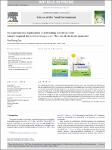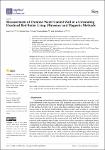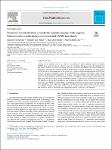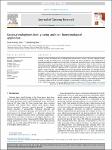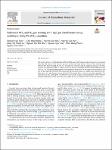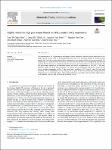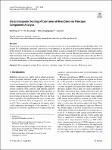Search
Author
- Anh-Tuan Le (12)
- Quan-Hoang Vuong (12)
- Ngo Xuan Dinh (8)
- Minh-Hoang Nguyen (7)
- next >
Subject
- Nanoparticles (4)
- Open Science (4)
- Compound droplet (3)
- Economics (3)
- next >
Has File(s)
Search Results
In this study, the synthesis of micro-wheels composed of self-assembled tungsten oxide nanorods supported platinum (WO3/Pt) by atmospheric plasma reduction and its application in a counter electrode (CE) for highly efficient dye-sensitized solar cells were discussed. To characterize the developed materials, we conducted SEM, TEM, EDS-TEM, XRD. Due to a large surface-active area of developed material and its support for Pt nanoparticles in diameters of 2–3 nm, the WO3/Pt electrode indicated as a greater electrochemical catalyst for the redox reaction than Pt and WO3 CEs. Thus, the power conversion efficiency for a device with WO3/Pt electrode is improved to 8.10%, compared to 4.36% for a device with WO3 electrode and 7.61% for a cell with a Pt electrode. This study also supplies a pr... |
It is a challenge to harvest both electricity and freshwater from the oceans. This communication demonstrates that the natural-inspired hierarchical evaporator based on multi-walled carbon nanotubes can generate electricity via water evaporation for freshwater production. Furthermore, for the first time, the effect of the nature of exposed electrodes in an electrolyte solution and the distance between two electrodes on the generation of electricity is carefully investigated. We found that the natural-inspired hierarchical evaporator could generate electricity for all time of the day. The proposed natural-inspired hierarchical evaporator is scalable, feasible, and low-cost, providing great potential for direct industrial applications of solar energy on clean water and electricity gen... |
In this paper, a nondestructive inspection system is proposed to detect and quantitatively evaluate the size of the near- and far-side damages on the tube, membrane, and weld of the water-cooled wall in the fluidized bed boiler. The shape and size of the surface damages can be evaluated from the magnetic flux density distribution measured by the magnetic sensor array on one side from the center of the magnetizer. The magnetic sensors were arrayed on a curved shape probe according to the tube’s cross-sectional shape, membrane, and weld. On the other hand, the couplant was doped to the water-cooled wall, and a thin film was formed thereon by polyethylene terephthalate. Then, the measured signal of the flexible ultrasonic probe was used to detect and evaluate the depth of the damages. ... |
Recently, auxetic cellular solids in the forms of honeycombs and carbon nanotube reinforced composite (CNTRC) have great potential in a diverse range of applications. This paper studies the nonlinear free and forced vibration of sandwich cylindrical panel on visco-Pasternak foundations in thermal environment subjected to blast load The sandwich cylindrical panel consists of auxetic honeycombs core layer and two CNTRC face sheets. The Poisson’ ratio of the auxetic core is negative and the material properties of CNTRC face sheets are assumed to continuously vary in the thickness direction according to four different types of linear functions. The blast load is determined from the distance of the center of blast to center of the structure and the mass of explosive materials. The fundam... |
Ginseng has been well-known as a medicinal plant for thousands of years. Bacterial endophytes ubiquitously colonize the inside tissues of ginseng without any disease symptoms. The identification of bacterial endophytes is conducted through either the internal transcribed spacer region combined with ribosomal sequences or metagenomics. Bacterial endophyte communities differ in their diversity and composition profile, depending on the geographical location, cultivation condition, and tissue, age, and species of ginseng. Bacterial endophytes have a significant effect on the growth of ginseng through indole-3-acetic acid (IAA) and siderophore production, phosphate solubilization, and nitrogen fixation. Moreover, bacterial endophytes can protect ginseng by acting as biocontrol agents. In... |
The selective detection and classification of NH3 and H2S gases with H2S gas interference based on conventional SnO2 thin film sensors is still the main problem. In this work, three layers of SnO2/Pt/WO3 nanofilms with different WO3 thicknesses (50, 80, 140, and 260 nm) were fabricated using the sputtering technique. The WO3 top layer were used as a gas filter to further improve the selectivity of sensors. The effect of WO3 thickness on the (NH3, H2, and H2S) gas-sensing properties of the sensors was investigated. At the optimal WO3 thickness of 140 nm, the gas responses of SnO2/Pt/WO3 sensors toward NH3 and H2 gases were slightly lower than those of Pt/SnO2 sensor film, and the gas response of SnO2/Pt/WO3 sensor films to H2S gas was almost negligible. The calcification of NH3 and H... |
The enhancement of the H2S gas-sensing performance of SnO2 nanowires is vital for practical application. In this study, H2S gas sensors based on WO3-coated SnO2 nanowires were fabricated through a two-step process, namely, the chemical vapor deposition of SnO2 nanowires and then coating with WO3 by sputtering method. The morphology and crystal structures of the SnO2 nanowires coated with WO3 were investigated by field-emission scanning electron microscopy, transmission electron microscopy, and energy-dispersive X-ray spectroscopy. The H2S gas-sensing properties of the fabricated sensors were tested at temperatures of 150–250 °C. The SnO2 nanowires coated with 5 nm WO3 showed the best response to low-concentration H2S gas (0.1–1 ppm). At the optimal working temperature of 200 °C, the... |
Detection of corrosion at rivet sites in a multilayer structure of an aircraft is an essential task to ensure the flight safety of an aircraft. It is challenging to detect the corrosion due to the influence on the signal of the rivet and the multiple fastened layers in the structure. In this letter, an electromagnetic testing method is used in conjunction with principal component analysis (PCA) to detect corrosion around fasteners. Multiple Hall sensors were used for efficient measurement of the magnetic field distribution at the rivet sites. The features of the scanned magnetic image were automatically extracted by the PCA in orthogonal subspaces. The proposed method shows potential results of features extraction and corrosion signal extraction for further development of electromag... |
Magnetic flux leakage testing (MFLT) is an important nondestructive testing method for the detection and evaluation of defects in magnetic materials. Magnetic field distribution in an MFLT system is usually simulated by the finite element method (FEM), which required large memory, high computation, and complication of the meshing process. In this paper, an alternative simulation method will be proposed using a deep neural network (DNN). The DNN method provides an easy way of simulation by feeding only the distribution of supplied current and the physical properties such as magnetic permeability without the need for the meshing process. Defects with arbitrary sizes were simulated under different configurations of the MFLT systems. The DNN was trained on the simulation results of the ... |
Dielectrophoresis (DEP) is known as an attractive and frugal technique to manipulate biological particles in microfluidics. This study presents the advanced solution strategy of a DEP-based microfluidic channel for focusing and separating cancerous cells in continuous flow. Theoretical calculations were carried out to define the favorable parameters in the electric field operation of the microchip. A simulation model was also used to explore the performance of the design in the isolation of circulating tumor cells (CTCs). It revealed that the optimal conditions of the device are suitable to effectively separate CTCs from red blood cells (RBCs) within the channel structure, with a high flow rate of 1.5 μL/min, and an electric amplitude as low as 10 Vpp, at the frequency of 1 kHz. The... |


